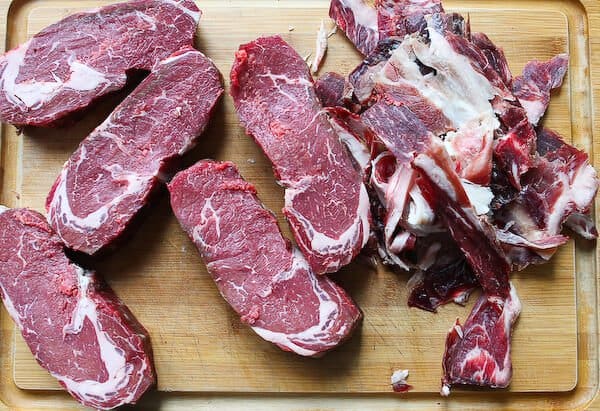
How to dry age steaks at home
What you’ll learn:
- How to dry-age steaks at home, with results just like expensive restaurants
- Use inexpensive vacuum bags designed just for dry aging beef, use your own vacuum sealer
- Honest review of the UMAi Dry Aged Artisan Steak Kit
- Step by step photos and see how steak ages
Updated 5/14/15
We’ve been using UMAi Dry Aged Steak Kits for the past 6 1/2 years. Back in 2009, I had contacted Thea, the owner of company to learn more about their Drybag Steaks product (the old name prior to UMAi). Their older model of bags required a special vacuum chamber vacuum sealer. They’ve redesigned the product so that you can use most vacuum sealers, like the FoodSaver. I tested their starter kit and this is an honest review of their product.
What are Drybags?
The bags are different — during the aging process, they turn into a membrane that allows moisture to escape but do not allow oxygen to come into the bags creating the perfect seal for dry aging steaks.
I’ve now tested this method 4 separate times over the past 6 months regularly for the past 6 1/2 years. For this post, I conducted 4 separate tests…twice with ribeye loin and twice with strip loin. I took about 300 photos during the 4 separate tests. THREE HUNDRED PHOTOS. I’m using the best of the lot – which means that the photos below are a mish-mash from all of the tests. So if the steaks look a little different between photos, that’s why.
A note of caution – for successful dry-aging, you must keep a steady temperature of 34F-38F. If you have an old, rusty, broken refrigerator, please do not attempt. Or, if you only have one refrigerator in the house and your kids open shut open shut open shut the door to sneak finger swipes chocolate cake frosting, you’re better off having someone else do the dry-aging.
I’d like to introduce you to hunk-o-meat.
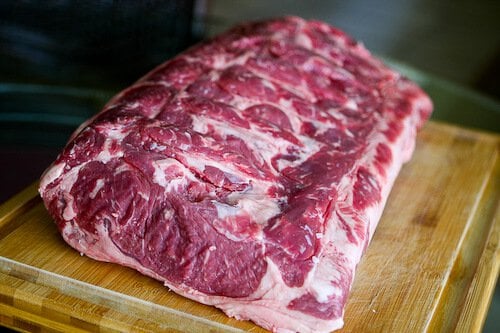
What kind of vacuum sealer can I use with Drybag?
The photo below is an old style chamber vacuum sealer – this is vacuum sealers used to look like prior to Food Saver. You can use many popular brands of vacuum sealer, though some are easier to use than others. The standard vacuum sealers that are flat are easier to override the automatic sealing function, which is essential when sealing the Drybag. The newer, tall sealers make it too harder to override – to manually tell the machine, “stop sucking, just seal.” But it can be done with UMAi’s new bag redesign. Here’s a video using a Food Saver.

This is my old-style vacuum sealer.
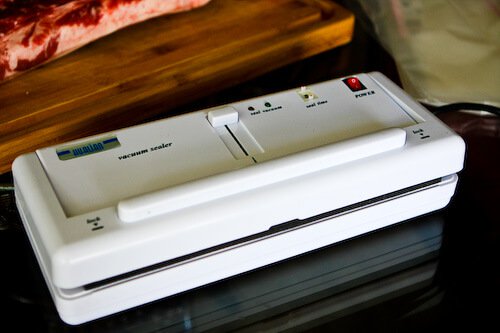
First, I want to cut the hunk in half. It’s too big to fit into the bags, whole.
Here’s a mistake that I made: do NOT trim the outer fat and when you first take the hunk-o-meat out of the cryovac that you bought it in, do NOT wipe off all that gooey bloody mess — Here’s why, explanation from UMAi Dry:
“To create the best (and, ultimately, safest) bond between the surface of the meat and the DrybagSteak material, it is critical that the meat be well coated with proteins–i.e. bloody and gooey like right when you crack it out of the cryovac if you purchase meat from Costco or Sam’s Club.” ~Thea, UMAi Dry
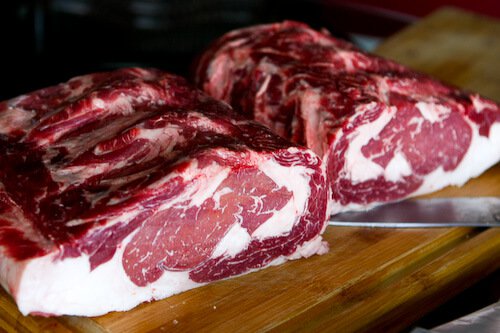
Put hunk into the secret weapon…the Drybag bag. Trim away excess, but leave some room, because you’ll need that extra space to insert into the vacuum sealer.
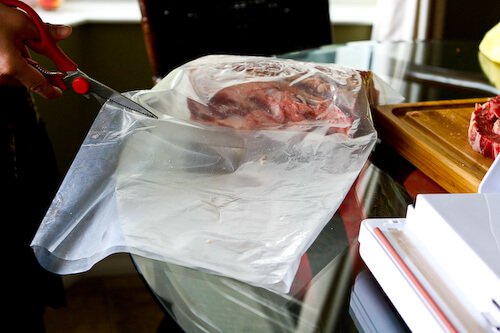
Vacuum seal that baby up.
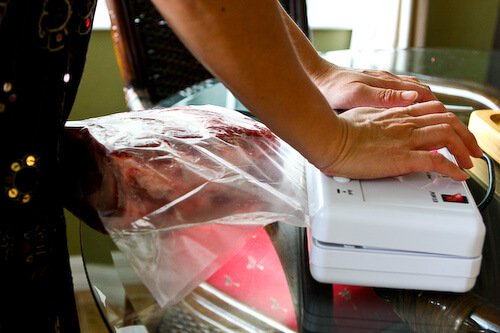
Get it good and tight. Oh and also, only UMAi Drybags work – it actually becomes a membrane. Don’t try to do this with other brand of bags. It won’t work. Foodsaver bags are thick and the whole point of DRY aging is to release moisture. Foodsaver bags will not release moisture. You’ll get sick.
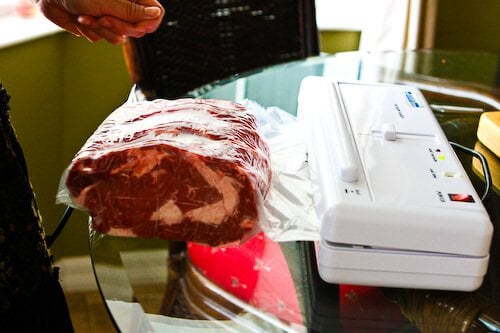
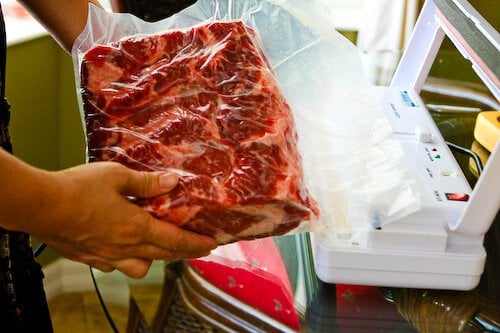
Place it in the refrigerator. Important: you want air circulation, so place it on a heavy rack. Also use a thermometer in the refrigerator to make sure it’s between 34F-38F.
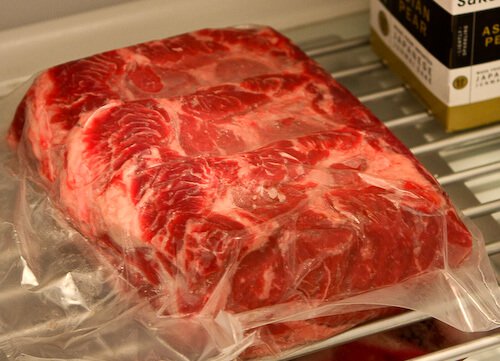
In fact, for test run #2, I propped the rack up with some boards so more air can circulate around the meat.
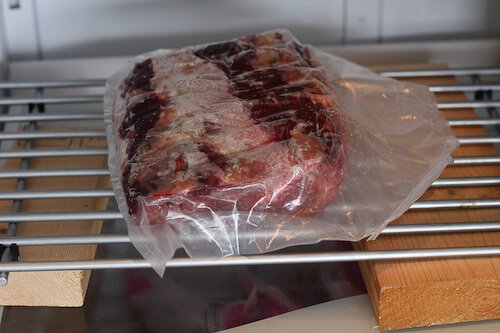
Notice that during one of my test runs that there is some trapped air inside the bag. This occurred part way through the aging process. This is not good. Trapped air = nasty stuff that gets in the meat. Remember I said I made a mistake– I trimmed the fat and wiped the bloody gooey goop from the loin? Well this is what happens. The membrane couldn’t get a good grip and cling.

It should be nice and tight like this:
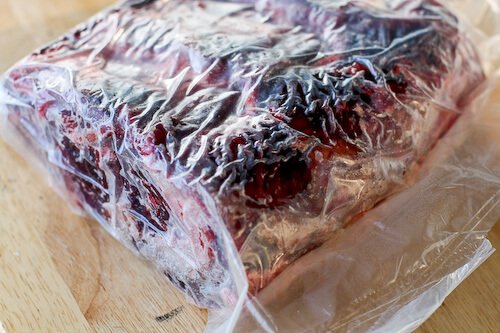
After 7-21 days (I aged for 14 days) the steak is ready! See how the Drybag bag clings? You should have to peel it away like a membrane. It comes off easily.
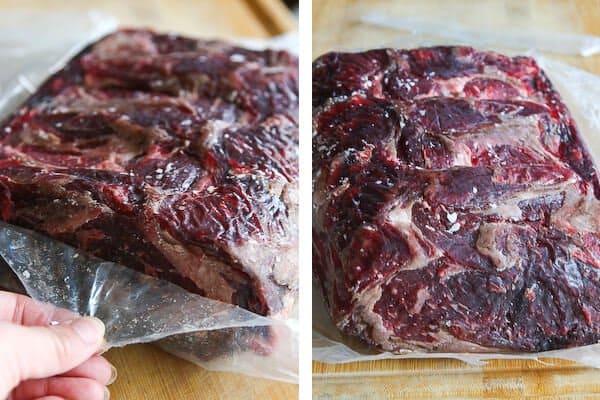
Trim away the outer, tough layer.
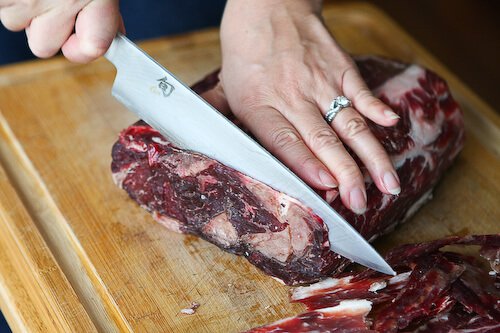
Do that all the away around the loin.
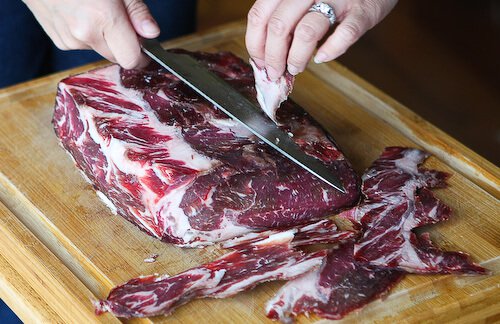
Trimmin’
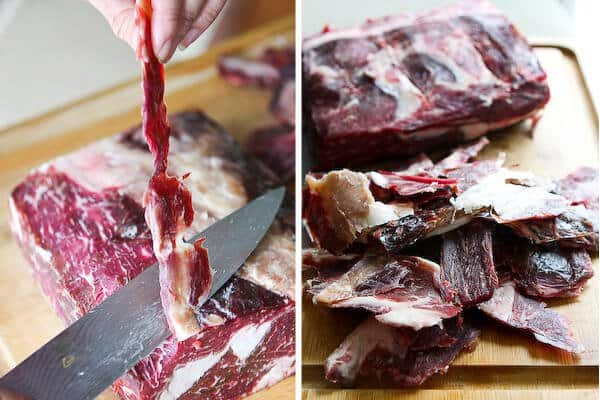
Now slice the steaks into whatever thickness you’d like. Look at the nice, deep red color that’s typical of aged steaks.
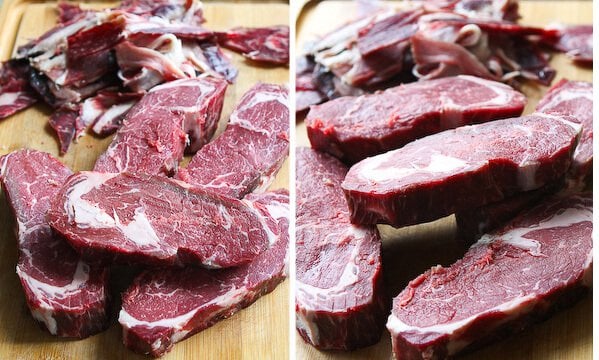
That’s some good lookin’ steak.
As for the taste? Fantastic.
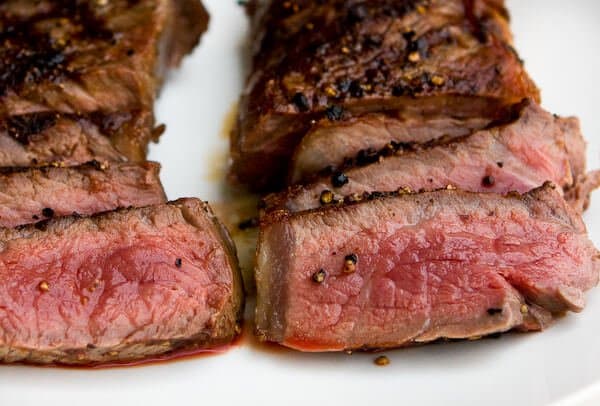
Like most well-aged steaks, it had incredible depth of flavor, deep beefy, earthy, complex flavors that hit every part of the mouth.
And like all steaks, taste and flavors depend first and foremost on how long you’ve aged the steaks, how well you cook the steaks, the breed of the cattle, what they were fed, how they were raised and where they were raised. In fact, you should probably read up on Artisan Steak Tasting.
But take your favorite steak and amp up the flavor and beefy-ness by 10x.
I think what you want to know is:
Q) Does it taste better than professionally aged steaks?
A) About the same. But that also depends on how long the professionally aged steaks were aged. And also results depend on making sure you follow the directions of Drybag (correct sealing, correct/steady temperature, air circulation) and the type of beef you are starting with. Good restaurants and butchers might be aging PRIME steaks…and I tested with CHOICE steaks. That makes a pretty big difference. But I’ll take affordable home-aged steaks over pricey butcher or restaurant steaks any day.
Q) Is Drybag more effective than home-aging without UMAI Dry Aged Steak Bags?
A) Both yielded same results for me, tastewise. When I dry age without the Drybag, I cover the meat with several layers of cheesecloth – which I have to clean every few days. The cheesecloth ends up getting dirty, bloody and crusty. I know, that sounds gross. The Drybag saved me time over changing and washing cheesecloths and worrying about exposed meat in the refrigerator. But it is an expense. The machine with bags plus shipping will set you back $130. Cheesecloth is cheap.
Q) Can I use my current Vacuum sealer and bags and do the same thing?
A) Yes, though some vacuum sealers are easier to use than others. UMAi has updated their product to include inserts into the bag that allow you to use most vacuum sealers. Here’s a video to show you how to seal with a Food Saver V3800.
FINAL THOUGHTS:
The new updates to the product (to include the Vac Mouse bag inserts so that you can use any vacuum sealer) is a big improvement and has take away many of the cons of using the UMAi Dry Age Steak Kit.
Sometimes, the bags are finicky. I had to try 2-3 times to seal and reseal the bags. My biggest advice to you is to leave yourself PLENTY of bag space in case you need to snip and reseal.
Also, part-way through the dry aging, I had to resuck and reseal the bags as I noticed air pockets as shown in the photos above. But this is minor compared to the ease over dry aging the steaks with cheesecloth. Again, cut your bags big – and leave yourself plenty of room to snip and reseal in case you need to.
I can see myself dry aging with Drybags probably 4-5 times a year – remember you have to dry age whole loins, not individual steaks. And a whole loin is massive. In fact, I’ll be dry aging the standing rib roast that we’ll have for Christmas dinner.
For ~$150 (which includes the vacuum sealer, instructions and the bags) it’s totally worth it. But also remember that Drybag is in the business of selling the BAGS…not the machine. You can get a few bags for ~$25.
Target market would be small restaurants and families who have an extra refrigerator/freezer. Since you’re dry aging an entire loin, you better have a lot of friends over to eat…or have the freezer room to store the cut steaks! Totally not recommended if you don’t have an entire shelf in your refrigerator to dedicate to this roast. If you’re refrigerator is slammed already for space and you have a family that constantly opens/shuts, I just wouldn’t recommend dry-aging at home anyways. NOT SAFE as the temperature fluctuates too much.
I use the refrigerator in my garage where I store drinks and booze…and it only gets opened when I want drinks and booze…which…is…um….quite…often. 😉 But still, it doesn’t get opened very much, and I have a fridge thermometer right on the shelf that I’m constantly aware of.
Once I’ve dry aged the loin, I cut them into 1 1/4-inch to 1 1/2-inch steaks and vacuum seal (with my regular Foodsaver vacuum sealer) each steak individually to store and freeze. For my Christmas standing rib roast, I’ll leave it whole.
In terms of number of days to age, I’ve tried 7 days, 14 days and 21 days. The 14-day aging was my sweet spot. Not that 21 days didn’t taste better (it did!) but I’m just impatient like that and it’s hard for me to wait the full 21 days. For Christmas, I think I’ll do the full 21 days. But that’s just because impatience can’t get in the way. Don’t think my family will stand for having Christmas dinner 7 days earlier just because I wanna eat the damn roast.
I’m still unclear on the science of how these drybags work – how does the bag let moisture out and keep oxygen from coming into the bag? Hmmm…if you have an explanation, please let me know! I’ll enter into this post. If you know of other companies distributing similar bags, I’m happy to contact them and test to offer options. Would I recommend the buy? It’s expensive. An entire loin to dry age is expensive. But if you’re a steak whore like me, and can afford it, go for it. Our friends and family *love* the steaks we dry age.
And if dry aging steaks doesn’t appeal to you, how about tenderizing and flavorizing your steaks using this post on salting steaks!?
UPDATE #1: Commenter Bruce has the best explanation I’ve heard so far:
“I’m guessing that the bags work by having tiny holes of just the right size. Oxygen molecules (O2 – two oxygen atoms stuck together) are a bit bigger than water (one oxygen with two hydrogens, but hydrogen is really, really small)”
UPDATE #2: I love my readers! This is from Ron, who’s a regular participant in the Big Green Egg Forums. He uses a 4-inch sleeve of the Foodsaver bag OVER the Drybag bag — and then seals with this Foodsaver. I haven’t tried this method….curious to find out how that works. See his photos and his videos.
UPDATE #3: The owner of DrybagSteaks has emailed me more information about the science and testing of these bags.
Dry aging of beef in a bag highly permeable to water vapour
Effects of dry aging of bone-in and boneless strip loins using two aging processes for two aging times
Support this site!




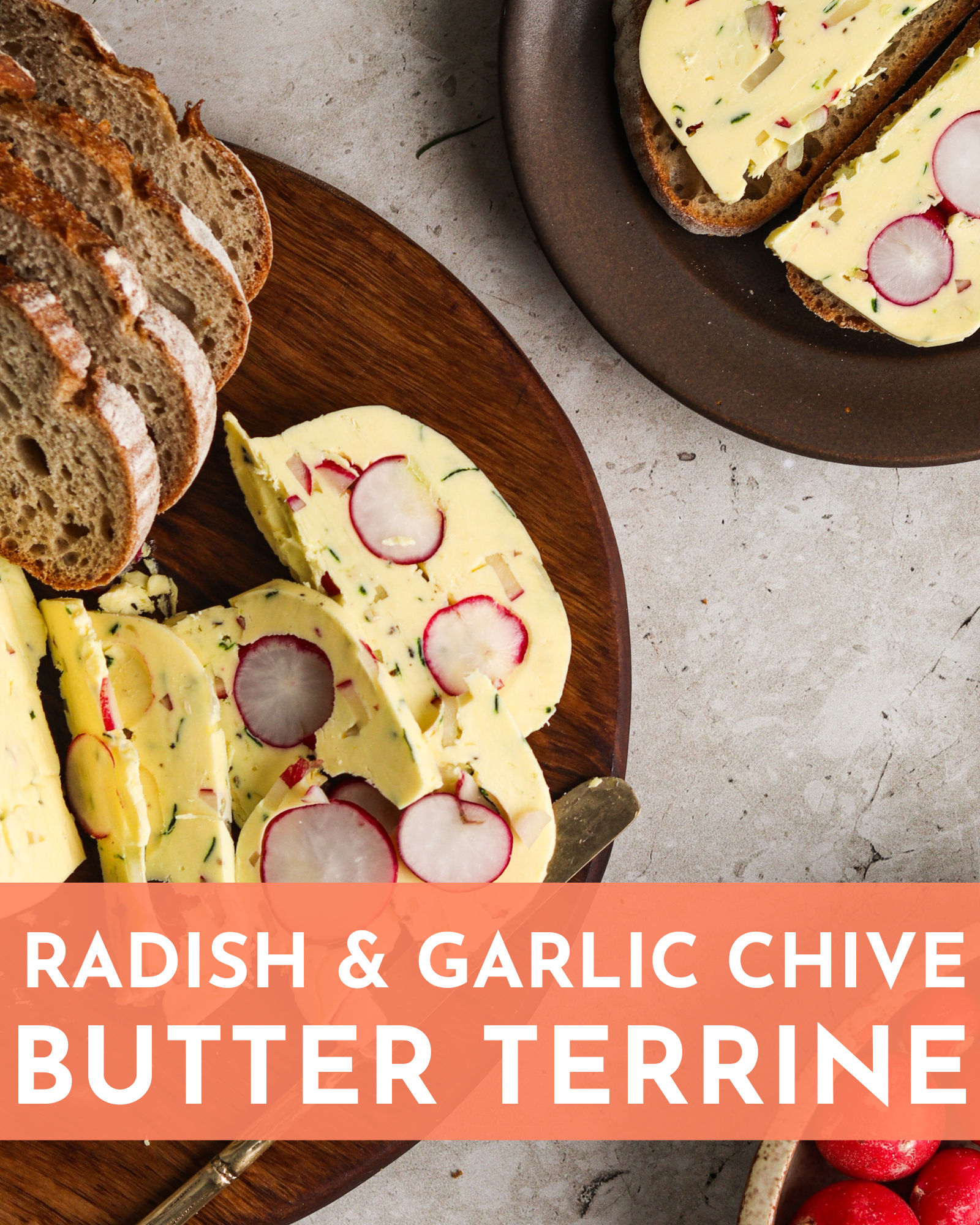
I’m going to test using the UMAI process and age my next round of striploins in the SteakAger Pro 40 I bought. I’ve done 3 x 14# striploins the traditional way with good results except for ice build up in the unit which honestly speaking baffles me!
what can you do with the hard cuttings. I think its called pinecal . I heard you can make stock out of it. Can you eat it?
Select your preferred type and grade of beef in any subprimal cut, generally, strip loin, ribeye, top butt. Fold back the opening of the UMAi Dry® material and slide the subprimal cut of beef inside. Smooth the UMAi Dry® material carefully against the surface of the beef eliminating all air pockets. The critical factor for optimal dry aging results is the excellent bond that will form between the proteins coating the surface of the beef and the UMAi Dry® material.
this UMAI drybag is really an useful thing, and as said in the post, this actually works as membrane and lets the food item breathe, yet does not let the oxygen come near it and let the food get rotten, am happy to use it instead of regular plastic bag.
would like know where bags are manufactured as I would like to import them into Ireland, sounds very interesting.need manufacturer not distributor,if you can help me please.regards Gerry GALLIGAN
The dryaged bags are made in Lithuania
I went to DryagSteak website and guess what, they offer a new bag version for Foodsaver units, they call it UMAi VacMouse® adapter strips for use with FoodSaver-type sealers.
BR
Francisco
I am dying to try this drybag and to do some real good steaks. I have one question: how come the meat doesn’t spoil even if sitting in the fridge? I know that for charcuteries, everybody (even Umai) uses curing salt to prevent botulism. Thanks in advance.
Wow, so much work and time (both the DrBag method & the salting)! Why don’t meat markets/grocery stores sell aged beef anymore? I would pay double the price & I am sure a lot of other people would, too.
I have my first striploin blackening nicely on a rack in my fridge. It will be 28 days by the time we eat it next week. So exciting! I am Australian and generally I would buy prime meat from a butcher shop,not a supermarket, and they would have removed all the enzymes and “gunk” on the outside. Does this matter? On some videos about this dry aging, they say to pat the meat dry with paper towels. It can be a bit confusing! I would appreciate some feedback. By the way – you Americans pay next to nothing for your meat – I would pay 3 times as much. Lucky you. 🙂
About the dry aging can you marinate the meat before you put it in the bag to seal it up ?
Or do you have to age it first then marinate it after it has finished aging?
Thank You for your reply
I would suggest NOT using marinade during the aging as the marinade is wet and will spoil the meat.
What kind to do with ending would you like to come across for Dr.
For some looking for his or her dream house, Gambling Beach
is where to search.
Balboa Park is a functional 1200 acre urban
cultural park with regard to San Diego, The golden
state. Shipping costs possibly even reflect the extra load of glass.
It is also helpful to pay attention to how the very agent interacts
with you. One of the most popular galleries is the Museo Inka.
If color is in fact not an issue, allow your organization to choose a person’s own color. Proposal your customized mens polo shirt as giveaways here at public events.
Some believe it means is actually no cost mixed up whatsoever.
A variety of special music much more absolutely perfect for the reason that
background music will be the New Age.
After which it is choose the household that perfectly works with
with your team.
Hi! is it still advisable to do the 1hr salting as posted on your other articles? https://steamykitchen.com/163-how-to-turn-cheap-choice-steaks-into-gucci-prime-steaks.html
I know this is an old post, however i was looking at Drybag, and they now offer a VacMouse adapter for foodsaver type sealers. I haven’t tried any of this yet, but I like this concept better than “old school” dry aging for at home use from a safety perspective. Ill be giving it a try anyway. AFTER I finish building the new smoker….one thing at a time!
I used to trim the whole sub-primal. Now, I have found it easier to just trim the ends, slice into steaks, and trim the individual steak. Also found this to be more thrifty in not cutting away edible hunks.
thanks for this post it clears my doubts thanks by Real pay day cash
I will try this one.
nice inforamtion site.i find my best topic here.i never seen a best site before.lot of thx admin for create this awsome site
Guitare les references sites web topliste classement pages guitare
topliste topliste classement sites guitare cours de guitare évolutivement à la guitare, leçons de guitare pros réalisés par un enseignant guitare
expériementé auteur de nombreuses méthodes pédagogiques.
Des cours de guitare complets et progressifs avec clips vidéos pour rendre l’aprpentissage encore plus facile et ludique.
Vous allez découvrir pas à pas les bases de la guitare, à placer les différentes notes de musiques aux différents enrroits du manche de votre guitare,
vous allez également découvrir les accords majeurs et mineurs à la guitare.
Des cours de guitare réalisés par un véritable guitariste pour les guitaristes qui veulent apprendre sérieusement et réellement la guitare dans les meilleures conditions.
Une méthode guitare complète ludique et terriblement efficace pour jouer rapidement vos morceaux de musique favoris, seul(e) ou en groupe.
leçons de guitare
Inscrivez vos sites
yeah mexico meat is so tough how can you eat that you guyz must be brave
We live in Mexico and the meat here is very very tough and usually very disappointing. Me think the cows are very tough cattle that exercise a lot! Anyway, thank you so much for this article. I cannot wait to try this. Tonight we are trying your salt cure to break down the protein in the steak and suck out the moisture.
has anyone tried to take a snip off a conventional sealer. put it over the end of the bag and then seal…bet that would work just fine.
There is, indeed, another company that produces vapour permeable bags for dry aging; the company’s name is UMAi and they actually recommend food saver vacuum packers. Apparently, the way that they get around sealing the thin material with a food saver system is by employing a strip of material they refer to as a “VacMouse,” looks like a strip of paper towel, but allows for proper sealing.
My personal preferences are inconsequential, however, rather than the term “commando,” I’ll go with “Old School” and bagged, Old School, or Old School over a tray of course sea salt, I believe that the true key to surviving such endeavors is adherence to sound, tested scientific protocol.
Good luck to all, do your homework and enjoy!
R
I have tried dry bags and they work well. I think they are really useful if you have very little patience or courage to do it the traditional way or so-called “commando” style. I suppose the real upshot for drybags is that it doesn’t allow oxygen to be in contact with the meat, and so ensures a relatively safe process. It is only through the exposure to oxygen that encourages bacterial growth etc. which causes spoilage. And i suppose that allows u to open the fridge a little bit more often than if you were to leave an exposed meat in the fridge. I personally can attest to that as i live in a humid tropical country, Singapore (no we are NOT in China), and each time the fridge is open, it allows a large drop in temperature and a whole load of humidity in. You can imagine that isnt too good for the meat. However, even having said all this, i personally dry-age my meat commando style. But this is only because i’m a little bit mad or perhaps courageous would be a better way to put it. But yes, i do have a designated fridge solely used for dry aging. I practically never open the fridge except to check on the meat which is approximately once every 5 days or so. I have done a 21 day striploin so far and it turned out pretty well. currently doing a 5-rib with the chine bone and a whole lot of fat cap left on as well as a 10lb porterhouse.
I truly hope someone has already replied regarding “using” the trimmings.
DO NOT do ANYthing with them other than throw them away, regardless of how the seemingly HUGE waste of an expensive piece of meat. The amount you toss will cost far less then the hospital visit and likely stay.
Cheerio
One thing that struck me was the amount of meat wasted in this process. Would you be able to use the beef trimmed off to make beef broth, stock or bullion? I make homemade stocks all the time to enhance flavor in dishes, would there be any reason this would not be an acceptable way to use the trimmings?
Thanks, i sent them an email.
do you sell the bag material in bulk rolls? so the user can make their own bags to the size they want?
I don’t sell them. You might want to contact the company directly.
DrybagSteak is no at all like “cry-o-vac” type laminated vacuum material. It is a moisture permeable material, like a membrane. Think Gortex for meat.
Although you use a vacuum sealer to facilitate the application of DrybagSteak, it is nothing like a vacuum bag. If you are going to dry age with DrybagSteak, bear in mind that the material is oxygen permeable. This means that, unlike regular vacuum bags, any small pockets of air will not develop dangerous anaerobic bacterial environments. Wherever the DrybagSteak material does not bond completely with the surface of the meat, you will find that the age will go slightly deeper requiring you shave off just a couple millimeters more “bark” in those spots at the end of aging. As Jan says, there is no need to be too careful. A nice vacuum and seal simply makes for the easiest aging with the least waste. No matter how perfect or imperfect your bond, you are bound to have more consistent flavor results with DrybagSteak than by going “commando.”
Wow, this sounds great. I’m inspired now to learn more about doing it the old-fashioned way – I’m a big fan of traditional techniques. Great info on the bags as well!
I have been dry aging with DryBags for about a year now (over 20 primals.) I mostly do NY Strip, but occasionally rib eye, and am no trying a Sirloin. I have done from 14 – 28 days, average is 21, and never had one screw up even of there were some small air pockets.
I have heard from fellow users who have skipped the snorkel vacuum and just squeezed most of the air out and used a twist tie and had good results. I think there is no need to be anal about this. I know other folks who dry age their meat “commando” and don’t get sick.
I’m a little conservative, but just do my best to get a decent seal, and put it out of my mind. Several hundred steaks later, I am still going strong. Cheesecloth is cheap, but time is not.
Once I put one of these puppies in the “beer fridge” it is forgotten about until three weeks is up. I mostly use Angus (like upper Choice) but occasionally do a Costco Prime. The family agrees Prime is best, but anything dry aged beats the best of the supermarket case by a mile.
What you decribed is not dry agging but cryoc=vack aging which is putting the meat into a plastic pouch and vacume pacing the meat. Then the vacume created insid the pouch drows out the excess mousture from the meat.
To dry age you must do it the following way.
1)It must be done in a separate refrigerated box
2)It must be held at temperature for 28-32 days
3)It must be held at 34-38 degrees F. This will require an accurate thermostat
4)It must be held at 50-52 % humidity
5)No saw dust on the bottom of the cooler as this introduces other bacteria to the cooler
6)put paper towels on the bottom and change every day. The blood or moisture drips onto the towels more at the beginning less after a few day
7)The meat should be placed on racks not on shelves as you want air circulation around the meat.
8)It would be best to have a very small fan in the cooler to circulate the air inside of the cooler, i.e. not a fan drawing air into the cooler but to circulate the air that is already inside of the cooler.
For those interested in the DrybagSteak product they now have a forum where you can read and ask questions of other users. Here is the link:
http://www.drybagsteak.com/forum
I didn’t read this whole blog but a comment on the vacuum pumps. Zip lock, maybe others too, have started making a manual hand pump you may want to look at. It doesn’t have a nozzle but a gasket that encompasses the seal on their vacuum bags. It would be easy to adapt to a nozzle. Mickey
Someone earlier on mentioned ordering grass-fed beef. I’ve been buying grass-fed from local producers for a number of years, but always just a few cuts at a time. This month, some friends and I are splitting an entire cow (!).
Without getting on my grass-fed beef soapbox, let me just say that you can order in bulk and get great savings, not to mention that a lot of tradional butchers dry-age their beef anyway. Best of all worlds, IMO.
I used the heavy salting technique with some trepidation…it works. Until about 8 months ago my steaks where consistently lousy. Other than salt I do the following: let steaks get to room temperature, heat an iron skillet to a very high temperature, put olive oil and pepper on steak, sear the steaK on each side (ABT 4 MINUTES), put on a cookie cooling rack and let rest for 15 minutes. Have the oven heated to 425 put the steaks back into the iron skillet, cook in oven for 12 minutes, take out and let rest 10-15 minutes…I usually last 5-8 minutes. Really turns out well.
Wow what a fabulous and informative post. I didn’t even know you could age steaks yourself. I look forward to giving this a try and making my steaks taste like they came from a high end steakhouse.
Nicely done Thea, nicely done. Concise and factual.
I had my first ribeye this evening from my first ribeye loin, drybagged for approximately 20 days. It was the most delicious ribeye I have eaten, and I am looking forward to the next, and the next, and more after that. Wow.
Thanks for making both the snorkle vacuum and the bags available.
“C~W”
First of all, as owner of DrybagSteak, I am sorry to hear this customer is unhappy with the results of his DrybagSteak aging process. We hope he knows we appreciate his feedback and would like to respond to his concerns directly.
Second, his description of unpleasant taste after aging in DrybagSteak material is unique and surprising. In the two scientific studies with professional taste panels, there was no mention of off flavors resulting from aging in DrybagSteak material. In all restaurant tests, there has been no mention of unpleasant flavors. If anything, the LACK of the funky, oaky, musty flavors one gets with traditional open air aging has been the only consistent comment regarding unsatisfactory results in flavor.
Regarding aging time, the website only mentions aging times as standard to common practice. In fact, DrybagSteak has been used with aging at all of the generally accepted lengths of time with equal or better results to traditional air aging in controlled studied. Whether 14-, 21- or 28-day aging periods, DrybagSteak aged beef has produce excellent results, with most steak house chefs preferring the 21- to 28-day aged flavors.
One last note on the scientific side, DrybagSteak material is not a plastic bag, and defies many of our assumptions about plastic. It will allow a vacuum to be pulled, but is highly oxygen permeable. It will not “leak” moisture, but will release it from the inside area of greater moisture to the outside area of lesser moisture as a membrane would allow for osmosis. The microbacterial studies done by Kansas State University and twice published in Meat Science have shown that the material does not create a dangerous anaerobic environment on the surface of the meat inside the material. Strangely enough, the microbacterial activity on the surface of a traditionally open air aged piece of meat has greater diversity and potential for danger–particularly in an aging environment that lacks ultraviolet lighting to keep down mold growth. In other words, if you want to dry age “clean” and safely in any refrigerator or cooler, excellent air flow and the application of DrybagSteak material is the combination most likely to give you excellent results.
Please let us at DrybagSteak know if your results are otherwise.
Bill, what was your refrigeration method on THIS one, and time and temperatures? I feel I have missed something here. My personal feeling is that if one over dry’s the meat with the drybags, you may have bad effects.
I believe I will stop at 3 weeks maximum, and perhaps earlier in the drying process.
My refrigerator ran at 34 degrees with humidity of 25 to 30 percent.
The drybagged meat was on wire drying racks with good air circulation.
Regards..
“C~W”
Have been dry-aging strip loins for several years.
The use of a drybag has brought about my first failure.
Though the drybag sealed well (had to be peeled from the strip loin) the meat took on an very unpleasant taste. Had to throw out about a $70.00 extremely beautiful Certified Angus short loin.
The dogs are eating at it, but even the dogs are not all that enthused about this chunk of meat.
Bought 6 Drybags, got 5 drybags left I will not use, anybody want a bargain?
Drybags + a ruined strip loin = over $100.00 down the hole..plus 4 weeks wasted.
My uneducated opinion, if the Drybag will let the water readily evaporate — what is to stop something not so benign from coming in the opposite direction?
Please remember this wasn’t my first dry-aging load of turnips.
My usual method is to “paint” most of the lean portions with approx 1/8 inch of freshly rendered beef tallow.
With the Drybag I had hoped to eliminate having to remove the tallow covering and dispose of it, clean up, a little inconvenient and slightly messy procedure, but I never had a dry-aging failure with my “paint” method either.
Bill,
I’m active on a couple boards where we discuss Drybag results on a regular basis. Yours is the first bad report I’ve ever heard. I am highly suspect that your coating of rendered beef tallow was at fault, not the Drybag. You have introduced bacteria that was allowed to turn rancid inside the sealed bag. The fact you have used this method successfully before without the Drybag doesn’t surprise me since air could readily get to it.
C~W,
My longest and best beef yet was a prime rib primal I aged for 35 days. My next one will be 45 days. As for other experiences I have found 21 days is best for NY strip primals and 28 days for thicker rib eye primals.
BTW… I didn’t mention this. The clip extenders and/or the toothpicks remain inside the bag with the meat when the sealing is finished. You can rewash the metal clip extenders and use them over and over again. You only need about 2 to 6 depending on how much your going to seal up.
Good luck again.. These are great eats.
“C~W”
A few tips for the drybag users. I developed a new wrinkle in closing the bags and preventing the bags from being sucked up into the snorkle tube.
First.. I used two toothpicks gently inserted into the snorkle tube to assist in inserting the bag to the snorkle. These worked perfectly in keeping bags open and the bags were sucked tight to the meat.
Next, I used jumbo 2″ size paper clips, unbent and reformed into desirable shapes to fit into the snorkle with two tips about 1/8 to 1/4″ long. The outside shaped like a arrow head.. And/or other similar shapes. Use your imagination.
I will suggest that you not try to drybag steaks less than 1.75 to 2″ thick. And if you do individual steaks, to not go longer than 7 to 10 days. Otherwise you get a very hard crusting and a lot of wasted meats.
Also, use the recommended VS-280 sealer and save a huge amount of headaches. The long term investment is worth it.
I just finished cut two loins.. and ribeye and a NYstrip from the drybag process ending in 18 to 20 days. I used the two toothpicks on these bags.
If you try the silver metal jumbo paper clips idea, you don’t need to make but a short diagonal pre seal on the bag ends. Thats a pain in the derriere.
The reason for the diagonals is only for the large bags as the ends of the sealer wires will burn a hole. When you do a small diagonal, you allow room for the full seal at the end process. This will make your sealing much, much easier to insert your snorkle and the wire/toothpick extendors.
Good luck.. if you need pictures e.mail me at bbq-dude@mchsi.com
C~W,
Great points and as always you are the problem solver! May I add my 2 cent viewpoint having to do with your suggestion of just aging separate steaks vs. full sub-primals? Until people get accustomed to seeing the dark flesh of dry aged beef – even for a short 8 to 10 days they will have a tendency to say “oooh” when they turn up their nose and proceed to trim it back to red. When they do that then they need to answer the question of “why did you bother aging the meat, only to have cut it off?” I trim off any excessive hard, aged fat, but only an extremely thin layer of the crustiest (if there is such a word) of the exposed beef flesh. I’ve learned that is where the taste is and besides when the steak has been seared that dark brown is part of the delicious bark.
I agree RRP… I never trimmed off the flat part of the steaks, only the edges. I had overkill on my 20 oz. T-bone cure, as well as two smaller thin ribeyes. Two NY strips last night were delicious, non trimmed and tender, very juicy, very tasty. Gotta love em. Now I am hooked.
I cut the dryaged Ribeye, and NYStrip loins today and bagged and sealed in Foodsaver bags. Now in the freezer. Looking forward to some super duper steak.
Cheers..
Can aging food especially meat in plastic cause cancer?
Mary…this isn’t plastic and should not be confused with Poly… The bagging material is a quasi porous material, developed especially for drybag meat processing. Go for it if your so inclined.. Just my opinion.
Slight correction here – I first placed the meat in my grill at a dome temperature of 300° and after it went from 85° to 125° internal then I removed it to rest while upping the dome temperature to 625° for that 3 minute sear.
Here is a prime rib from a sub primal that I had aged in a Drybag for 35 days. While it did in fact lose 19% of its moisture weight it was still juicy inside – I believe you can even see that glisten in this picture. As for salt I did hit the exterior with kosher salt in a shaker. I hot tubbed the meat for 1 hour to an internal temp of 85° before putting it on a 625° fire in my ceramic cooker called a Big Green Egg for a total of only 3 minutes for sake of the sear. This was extremely delicious and my next goal will be a 45 day aging.
Photos:
http://www.eggheadforum.com/index.php?option=com_simpleboard&func=view&id=821113&catid=1
How might the dry-aging technique meld with the gucci-salting technique?
I’ve got Drybags coming in the mail, and I’ve got access to a respectable amount of salt. Has anyone got advice on doing the salt draw after dry-aging (and trimming) the meat?
-Scott
sorry I missed this email! I dry age and then salt using my method. you won’t get as much moisture out (b/c it’s been dry aged) but it definitely affects flavor! nicely salted steak throughout.
Chau Tran,
keep in mind many of the big steakhouses do not dry age their steaks. Ruth’s Chris, Mastros, I know for sure wet age their steaks.
Ah… but Joseph, the BEST steak houses do go to the trouble to dry age. Lobels, Smith and Wollensky, Manny’s. It is easier to NOT age authentically. As Jaden has pointed out again and again, good beef takes a little effort–finding the artisanal source, salting or dry aging. Once you try them side-by-side with a so-called “wet aged” steak, you won’t go back.
–Thea
Chau Tran,
I have found my sub primals release 18% of their weigh via moisture loss when I use Drybags. I don’t call that waste and since I actually prefer to leave the dark brown meat layer on and not trim it then I don’t feel I have waste at all. That dark layer is tasty and I find it is just part of the tasty bark I get when I sear. Granted I will trim away any heavy aged fat, but I would have done that whether aged or not – so again I don’t see it as waste. I recently sealed a prime rib in a Drybag again using my method of a Food Saver bag sleeve inserted inside the Drybag and then sealed with a Food Saver. Works for me!
RRP
Steamy Kitchen, Thk you for a good review. Please answer this question since you have dry age beef using the drybags and the traditional method. How much waste does the traditional method create? It seems like the advantage of the drybags is that you only have a 10% or so waste of meat. While I haven’t age beef the traditional way, I’ve read you can have up to a 40% waste. That’s $ down into the garbage right there. The cost of the drybags alone far outweigh the cost of throwing good beef away.
Ppl dry age beef b/c they can afford to and don’t want to spend upwards of $50 a steak at the fancy steakhouses (Morton’s, Ruth Chris, etc). The cost of dry aging at home with the drybags per steak is significantly less than paying top dollar for a good steak.
BTW, the method of putting a foodsaver bag sleeve inside a dry bag will only work if the sleeve is the same width as the drybag. The heating element of the foodsaver is too hot for the drybags unless you find a way to thicken the drybag.
I have successfully used a deni magic vac vantage food sealer (a channel vac sealer similar to the food saver) and pulled an excellent vacuum seal with the drybags. I’m emailing the sellers of drybags to see if they are interested in repeating my methods.
In answer to Organic Baby Clothes I understand your reluctance but if you step back and look at the big picture you’ll find that buying large sub-primals of meat actually saves money let alone aging them yourself vs. buying aged meat. Once you have tasted aged beef you’ll be hooked! Like-wise I have shown how to use a Food Saver with Drybags. Whether you buy a Sinbo brand or a Food Saver brand those sealers are also a cost saving machine worth their investment in any serious kitchen. They are not some device that is seldom used! I for one know I will never be without one.
After all the Thanksgiving turkey, this post really made me wanna eat red meat! Wonderful post and very informative. The machine is a bit of an investment though. I try to stay away from gadgets that you buy, use once or twice and tuck away on a high high shelf… I might research and try the cheese cloth/kitchen towel method though.
Your brother need to use Poly sorin! Much better but, they don’t have the ad. budget:-)!
Wow, This is GREAT information, with the ability posted by RRP (Thanks) to use Food Saver machines, this I will try for sure!! In Thailand good quality Beef is either so over priced or just not available and I had pretty well given up on eating beef except at very high end Restaurants. (even more expensive and many times disappointing) So I will be giving this a shot
On another note, I tried the salt method from this by you.. https://steamykitchen.com/163-how-to-turn-cheap-choice-steaks-into-gucci-prime-steaks.html This turned out Fantastic!! I was totally pleased!! I also used the same salt method on a pork loin roast. It was Soooo good it was like gone on 60 seconds with everyone fighting for the last bit!! ( It was a 4 Kg Loin for 4 people, 3 of them Thai’s who normally do not go for large main meat course’s )
Thanks Sooo much!! I will be back often!!!
B@Bangkok
Here’s a writeup from the askthemeatman website that gives a simple, ol’ skool butcher approach to aging steaks. It’s a nice alternative to the vacuum sealers, and better for the environment eliminating plastic bag waste.
from: http://www.askthemeatman.com/is_it_possible_to_dry_age_beef_at_home.htm
“Be sure to follow each step carefully, for safety’s sake.
1. Only the top grades of beef can be dry aged successfully. Use USDA Prime or USDA Choice – Yield Grade 1 or 2 (the highest quality of Choice) only. These have a thick layer of fat on the outside to protect the meat from spoiling during the aging process.
2. Buy a whole rib-eye or loin strip. [You cannot age individual steaks.] Unwrap it, rinse it well with cold water, and allow it to drain; then pat it very dry with paper towels.
3. Wrap the meat in immaculately clean, large, plain white cotton dish towels and place it on the bottom shelf of the refrigerator – which is the coldest spot.
4. Change the towels each day, replacing the moisture-soiled towels with fresh. Continue to change towels as needed for 10 days, to 2 weeks. (See Step #7 for cleaning towels.)
5. After the desired aging time, you’re ready to cut off steaks from each end, trim as desired, and allow the rest to continue to age in the refrigerator.
6. If, after 21 days, you have not eaten all the meat, cut the remaining piece into steaks, wrap each steak in freezer-proof, heavy-duty plastic wrap, and freeze. The steaks will keep for several months in the freezer.
7. To clean the towels for re-use, soak the soiled towels, immediately upon removing them from the meat, in cold water overnight. Next, soak them in cold, salted water for 2-3 hours to remove any blood stains. Then launder as usual. [In olden days, butchers used to cover sides of beef with cotton “shrouds” during the aging process – this is essentially the same thing.]”
Thanks for going through all the hard work for us. I think I’ll just stick to your oversalted steaks method, though. Salt is cheap.
Rhonda, that’s awesome! I will email her next week – I really want to try this but have some questions. Thanks for the GREAT review, Jaden. I’m excited to try this!
-Dawn
I had a few questions about dry aging and contacted Thea at Drybag Steaks. She responded within an hour and gave me clear, concise answers. She is so knowledgeable and very generous with her advice!
Wow, thanks for the extremely informative write up! I’ve heard of the dry bags before, but you’ve really illustrated it well. This is monstrously valuable post.
Hi Thea,
Would the bags work with this sealer http://www.provacuumsealers.com/ ?
Thanks
Hi from Tokyo 🙂 Few restaurants offer aged steaks in Tokyo. It’s amazing to know how they are cooked at home… thanks!
I’ve been dying to try them since I saw oliver Ranch talk about them. I have this vacuum machine http://www.vp210.com/ and I am hoping it will work with one of these. Very tired of paying dry aged prices when I want a treat. Thanks for doing the long test!
Jo- here’s Thea’s response to you:
“To be perfectly honest, without trying it, I cannot promise anything. I can tell you that I have found the odd chef who had this type of table top sealer, just about this size (not sure of the make), and we ran tests with it. The trick is going to be adjusting the heating strip so that it does not melt through the single layer material of DrybagSteak. As you probably know, vacuum bags are laminated, multilayer bags that are either co-extruded or somehow laminated after being blown (I’m not plastics’ manufacturing guru). The inner layer of the bag is a softer, more easily melting plastic polymer that seals the bag while the outer, tougher (less oxygen permeable) layer forms the structure–and does not melt. Thus Ron’s difficulty with getting the little sleeve of channel sealer vacuum bag to adhere inside the DrybagSteak material when he does his adaptation for FoodSaver/channel sealers.
Anyhoo–that’s my two cents’ worth. ~Thea”
Sometimes reading through comments is anexperience in itself!
Anyway…this was a most informative post on a subject I know nothing about. It’s why I love blogging. You gave an honest review and I loved it.
You were “Pissed?” I stopped reading there. I don’t read about food to be slapped with vulgarities. Talk about food, not your bladder.
Great and informative post, Jaden! You nailed the problem with dry aging at my house….boys. I’m going to try the Alton Brown method in a small fridge I have set up in the garage, I just have to test it out to see if it maintains the right temp.
PS: It’s funny seeing several Eggheads here, I feel like I accidentally clicked on the forum 🙂
OMG! those photos did solicate my eyes! I realy need to try them! thanks Jaden!
Hi Jaden,
Do they address food safety at all in the directions? With traditional dry aging, the microorganisms change the PH and eat up all of the bad germs. I’m assuming the temperature is important to keep germs at bay, but can’t imagine the temperature slows down the growth of bacteria enough for 14 – 21 days? I’m intrigued, but food safety class has me skeptical.
-Dawn
Heed “J”‘s advice The aged fat is what imbues the “umami,” so you want to preserve as much of a fat cap as will fit in the bag. One side needs to be the open surface of meat, though. (Avoid aging a fat encircled tenderloin, for sure!)
Thank you for an informative and fair-handed review!
Here’s an updated “how to use a Food Saver with Drybags” post I made today on the Big Green Egg site. It even has an embedded You-Tube contact to a 5 minute video I made to show what/how I did it.
http://www.eggheadforum.com/index.php?option=com_simpleboard&func=view&id=764307&catid=1
I don’t eat red meat too often, so I don’t think I’ve ever paid attention to whether the meat has been aged or not when I order at restaurants. I never knew I could be eating a really old piece of meat! LOL. Thanks for the primer, now I’ll pay more attention to aged beef and see if I can detect any difference in taste.
You’re a better woman than I for having the patience to dry-age your own meat! I looooove dry-aged steak, but honestly, I’m not ready to go down that road. That said, it sounds like the bags/machine are a worthwhile investment if you plan to dry-age even a few times a year. Thanks for the honest review. There really is something celebratory about a great steak around the holidays. 🙂
You might consider not trimming the exterior fat at all until you are done. For one thing, traditionally it derves as a protective layer, and helps to slow the drying, but controlling how quickly the water wicks out from the surface. Secodnly, it can be trimmed to a quarter inch or less AFTER aging, and you won’t have to trim away hard leathery surface flesh. The fat, when traditionally aged, isn’t something in the way, it protects the meat throughout the process.
Your trimming doesn’t need to be as agressive. Rarely are dry-aged steaks (when purchased from a butcher who ages) trimmed so much. One reason is that they have that fat still around them, keeping the majority of the meat from getting too dry on the exterior. The other is, frankly, because dry-aged fat is far denser, has better mouth feel, and greater flavor than the soft wet fat of an unaged steak (especially the fattier rib eye).
Try it again without trimming the fat until AFTER. You will lose much less flesh to trimming. Some of us (tradiottnalists) don’t trim the steaks very much at all except from the very ends (exposed flesh). The thinner brown outer surface softens when grilled, and (to beat a dead horse), there’s less of it anyway because the fat will have kept it from going too leathery.
I do it without the dry bags, about 28 days (4 weeks), but the dry bags will allow you to age longer (say 7 weeks) without drying too much. Dry aging does two things, allows the meat to condense (water loss) and it allows the enzyems to break down the meat and add flavors in the process. The dry bag slows the drying to maximize the length of the enzyme effort.
Nice post. Just don’t throw away the best part!
Great pics.
Thanks for the advice! I’m off to the market now to get my Xmas roast – will not trim this one until after. ~jaden
Nice and very informative. I do not have the patience to dray age though. I tend to be a NOW person. I do know of a couple that will love this, will pass on to them and maybe if I am lucky they will invite me over for one of their dry aged steaks!
Thanks for the experiment!
This is a very informative review. This topic has been discussed a lot recently on the Big Green Egg forum. Several people in the group have used this product and have had very favorable results like yours. Thanks for the review and tutoral.
I am a Drybag fan. To date I have only aged two sub-primals – a 12 pound New York strip loin for 21 days and a 14 pound rib eye for 28 days. Results have been great and worth the effort! Actually once you get over the shock of laying out $100 or more for a chunk-o-cow do the math and you’ll see a nice cost savings over buying aged beef, let alone buying individually cut steaks. In my case every steak that I cut saved me $3 alone let alone much much more for dry aged meat. One last thing…I have been able to successfully insert a 4″ sleeve of Food Saver bag into a Drybag and seal all 4 layers together with an older model Food Saver that has a 5 second setting.
genius. love that Foodsaver sleeve idea! I’ll try that next time. ~jaden
ok, now that I’m craving some steak… 😉
WOW! I know it took you a long time to do this post. It was very informative! This is why I love your blog!!!! Now am going back to your post on salting steaks before putting out the money. But then I won’t have any excuse to go out to get a great steak!!
I love the old food arts- weather it’s dry-aging or brining or winemaking and canning. It’s fun to get in touch with what our ancestors did WAY before the modern conviences came about. Now, I need to learn how to preserve fish in salt- I think I will go google that now!
Dry bag is a solution for beef lovers who wants to prolong stocks of meat. I gained a lot about pros and cons on how to properly use dry bags.
Wow! What a great, educational post. I never thought of dry aging at home, but in these tough times it is such a great idea! Thanks for the detailed information.
You know, I really appreciate your honesty. You shoot from the hip and tell it like it is–and I had to laugh when you said you didn’t like the original, spammy comment left by the Drybag people. When will they learn?
Very informative post. You sure put those hunks to the test!
Great post and product review! I know I don’t have enough room in our current fridge, but I’m gonna have to get out the vacuum sealer we got as a wedding present to see if it has a nozzle.
Very informative post Jaden. I really appreciate all the time it took to test this out and take all the great photos! I just ordered about 40 pounds of grass-fed beef from a local farm, but I’m not sure if there will be large enough cuts to do this with. If so, I will definitely look into it. Thanks again!
I’m guessing that the bags work by having tiny holes of just the right size. Oxygen molecules (O2 – two oxygen atoms stuck together) are a bit bigger than water (one oxygen with two hydrogens, but hydrogen is really, really small)
Thanks for this post. I personally haven’t used any techy equipment for freezing my meats and stuff yet, but I’d like to. Seeing how I hold your opinion in high regard, I’ll be giving this specific product a hefty consideration. 🙂
This is an interesting idea. I trust that it works but I just don’t buy the whole idea of having to buy a special vacuum sealer (when I spent enough on my Foodsaver) plus special bags. Their sealer looks really “cheap” to be honest. Why would anyone make a sealer with a “special” nozzle. Bags seal fine with the channel.
As for the bags. Again, “special” bags? People used to think Foodsaver bags were special but we soon found out you could get generic brand bags that are made from the exact same material.
Thanks for taking the time to do the review. I have nothing against buying good products but I’ll be researching this a bit more before purchasing.
Well to be fair, Drybag focused in the business of selling machines, their focus is the bags. Yes, they do sell the machine, but you can get this vacuum sealer from any other source. It’s an old-style sealer waaaayyy before Foodsaver came out with theirs. This is how vacuum sealers used to work and look. So look on eBay or garage sales.
The bags are special b/c they are thin enough and allow water to evaporate. So as long as you can find a bag that allows water to evaporate AND is save to vacuum and seal then you’re golden. But good luck finding that – let me know if you find another source.
~jaden
I would TOTALLY go for the bags! I dry age our standing rib roast each year for Christmas, but the whole “you can’t use your current FoodSaver that you spent a bazillion dollars on” is a deal breaker. I certainly do not need another food sealer appliance.
Maggi–
If you want to dry age safe and sound, but don’t want anther piece of equipment, you could try this: http://www.youtube.com/watch?v=ytQGVYuHHKg&feature=player_embedded
or check out the alternative instructions on the eggheadforum.
–Thea
I’ve never even attemped something like this. My hub would love it.